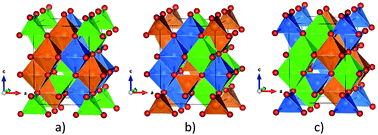High-throughput investigation of the formation of double spinels†
Abstract
Spinel compounds, with the general chemical formula AB2O4, are a wide class of materials, where A and B can be a variety of cations, providing this structure with a great deal of functional flexibility and giving rise to its considerable scientific interest. Recently, a spinel with the general formula ABB′O4 has been predicted, increasing the possible usability of the spinels due to the higher cation diversity in the so-called double spinel structure. Here, we use density functional theory calculations to predict if double spinels can be formed between experimentally synthesized normal and inverse single spinels. Our computations reveal that 49 double spinels have negative mixing enthalpies and are thus thermodynamically stable, with most of the stable compounds being formed from one of two distinct cation orderings. We show that the 17 different cations that form the different double spinels have a preferred site, tetrahedral or octahedral, except for Mn, Fe and Co which can occupy both sites interchangeably. We also study the relation between mixing enthalpies and cation-specific properties, as well as ways to classify the double spinels into distinct types and spinel groups depending on the cation ordering and cation oxidation states, respectively. By applying the Sure Independence Screening and Sparsifying Operator (SISSO) approach on the coordination-dependent ionic radii of the elemental constituents, we show that an interplay of local strain and electrostatic dominated terms can be used to separate the double spinels into distinct structural types depending on the cation order and their oxidation states.

- This article is part of the themed collection: Journal of Materials Chemistry A HOT Papers


 Please wait while we load your content...
Please wait while we load your content...
